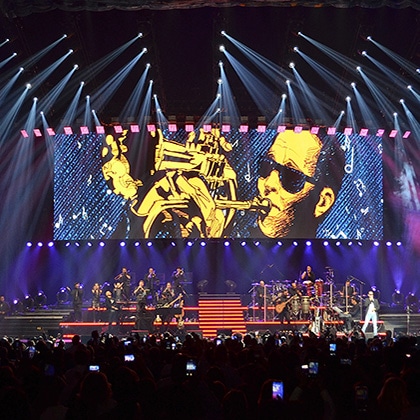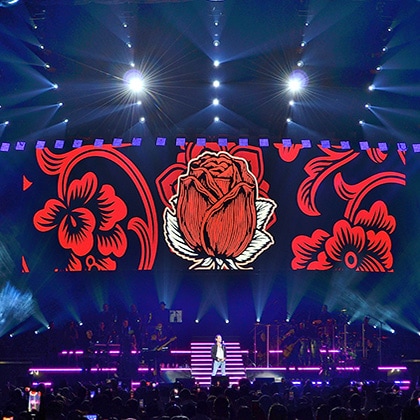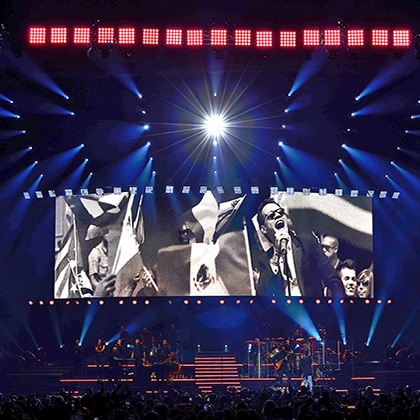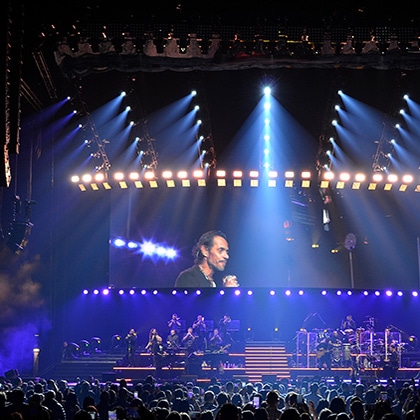
Andres Campos is an experienced lighting designer & programmer who is also a key programming trainer for MA Lighting. He worked as a Lighting Designer & Director with American singer-songwriter, Marc Anthony's, producer, Roly Garbalosa, and Hawthorne, CA-based music company, Garba Music Corp. His design credits also include work with Colombian Reggaeton star J Balvin, among many others.
Where and when did you first become interested in lighting?
My first encounter with lighting was when I was very young, and I was standing on a theater stage watching the lights. Later, when I was 15 years old, I started doing the lighting at a Christian church in Bogota, Colombia.
How did you turn that interest into a career?
Three years after starting at the Christian church, I had fallen in love with lighting and, at that time, I understood that I would sacrifice everything to fulfill my dream and do what I love.
What shows and artists have you designed for?
Over these past 16 years that I have been doing what I love, I have had the pleasure of working with many different artists such as Marc Anthony, Jesus Adrian Romero, J Balvin, and Ozuna, among others. I have also been lucky enough to work as a designer and lighting director for various DVD recordings, beauty contests in Colombia and the Dominican Republic, festivals, such as the Festival Presidente in the Dominican Republic, and a number of television programs in Colombia.
What advice would you give to those who aspire to follow in your footsteps?
The first advice I would give them would be not to be like me - be better than me! The second advice is that everything they dream of will come true if they pursue it with effort, dedication, and passion.
Do you have any personal career highlights that come to mind?
I would mention three main highlights in my career: the first one was the creation of my studio and lighting design company, which joined with another company in Mexico to expand our market. The second one is working with one of my favorite artists, Marc Anthony, which came about thanks to my great friend Alex Soto. The third one is to have fulfilled one of the dreams I had when I started my career, which is to work for MA Lighting as a console trainer.
What achievements have given you the greatest satisfaction and why?
I think the most important achievement I’ve had are my friends in the industry. Together we have gone through a number of trials and have always been there for each other, no matter who we work with. A job is easy to find, but a very good friend is not.
What would be your dream show to light?
I think one of the shows I dream of designing and lighting would be a big world festival, something like Tomorrowland.
You are a top programmer/operator and one of the leading GrandMA specialists in Latin America. How did you develop into being a designer?
In 2007 I started designing small lighting scenarios in wysiwyg. I practiced constantly with this software, and over time those designs became reality, and I understood that I wanted to live this way.
Was being a designer always your aim?
Yes, ever since I finished school it was clear to me that I wanted to be a lighting designer and make history.
How do you think of yourself - and how do you describe to others what you do - in terms of ‘art’ and ‘tech?’
I see myself like a dreamer artist. I believe that what we do is an art, which I love unconditionally. I think that the stage is our canvas, and the lights, video and sound are the paint. The mixture and balance of these colors and textures gives us a beautiful painting, and using the latest technology helps us to make the painting more majestic.
Do you think you have a ‘style’ of lighting? If so, how would you describe it?
I believe as every musician has his sound, every lighting technician has his way of doing lighting. Over time I have been able to create my own style of lighting, but I continue working every day to improve it and to do something different and original.
What are your lighting design rules? What do you always do/never do?
The main rule we have when designing is to create something that is unique and aligns with what the artist needs and dreams. Something that we always do is to be able to transmit with the lighting what the artist and his music wants to transmit, becoming a part of the band, and creating sensations. We try to make the music more visual.
When you approach a new lighting design, where do you find inspiration?
My first inspiration is God. Then we look for visual, natural, and architectural references to have a starting point, then we make a mock-up of the design where we gather all the ideas together, and then start to shape them into the design program.
Show production calls for high-level collaboration, with exceptional communication and understanding between disciplines. What techniques have you developed to ensure that this process runs as smoothly as possible?
I think the best discipline is to recognize when you make a mistake and try not to make it again. You must understand that you don't know everything, and that you can always learn something new.
What traits do you admire most in the creatives you collaborate successfully with?
The ability to work as a team, their humility, their strength, their leadership, and the ability to recognize when they make a mistake.
When you approach a new design, do you think in terms of specific lighting fixtures, or do you think just in terms of the desired light effect/performance?
At the moment of creating a design we already have a list of predefined equipment with which we work, which fulfills our needs and expectations. Added to that, we keep ourselves constantly updated about all the new fixtures that come onto the market in order to test them and decide if we can use them in our designs.
How do you keep up with developments in lighting technology? Do you read the trade press, or attend trade shows, etc.?
We constantly keep up to date, talking to lighting companies to find out what new equipment is on the way. We also go to different trade fairs like LDI in Las Vegas and the Prolight & Sound in Germany to see and test the equipment.
Which other Lighting Designers do you particularly admire?
The lighting designers I admire include Patrick Woodroffe, Alex Soto, Paulo Lebrao, and the artist and stage designer, Es Devlin.
Do you have ambitions to do lighting design in another area – theatre, television, etc.?
Yes, I would like to design theatre, and explore a little more the areas we have already worked on, such as television, architectural lighting, and product launches.
What are the main performance attributes you look for in a luminaire?
Mainly I look for a balance between power, color quality, zoom range, and textures. Clearly, this depends on each need, but in my opinion, I like very much to use fixtures that allow me to have a very good wash and a very good spot.
You recently spec’d VL10 BEAMWASH fixtures for Marc Anthony’s Opus tour – why did you choose that fixture, and what is your opinion of it?
I chose the VL10 BEAMWASH because it is a versatile fixture, which allows me to have a very good beam and an excellent spot with a quality of color, speed, zoom range, power, and gobos that is always majestic, no matter the distance. In my opinion, it is the best hybrid fixture currently on the market. It gives us the quality to which we are already accustomed with Vari-Lite equipment.
When you are specifying fixtures, how far is low power consumption a consideration for you?
Low power consumption and low weight are essential for a production because it all affects the cost of the show. The most important thing is to be able to find a balance between weight, low power consumption, and a very good power output.
What do you think of the current state of LED-based stage lighting fixtures on the market?
I think that LED products in the market are setting a precedent for rental companies, because maintenance costs are much lower, and their productivity and power make them a great partner when we do a lighting design for its low power consumption and low weight.
What’s missing from the Lighting Designer’s toolkit? What would you like to see from manufacturers?
I think we need a tool that will allow us to control any fixture as a followspot, regardless of the brand, using a tracking system that is easy to use and at an affordable cost. I think that manufacturers should take into account the lighting designers for both big and small artists to test their fixtures because they are the ones who will use it all the time and they know what they will need or that it can be improved to have a better performance.
Can you also tell us a little about your use of the Vari-Lite VL5 LED?
My experience with the VL5 LED was incredible. I had the pleasure to use them in February of this year in Dallas, Texas for Marc Anthony’s concert. I used them to replace two VL3500 WASH that I have a few of on stage. The VL5 LED is the most incredible LED fixture that I have seen so far. I love to see the temperature variation from 1800 K to 10,000 K, but the most incredible part is to see the variation of the CMY with respect to the color temperature.
I love to see the behavior of the VL5 LED in front of the cameras. Considering that with the VL3500, I used to dim them down to 45%, and with the VL5 LED I had to handle them at 25% with a temperature of 4500 K. This allowed us to have one of the best Marc Anthony’s TV recordings we had on the tour. The video director and camera director on the tour both commented that we should have them always, because they are a small fixture with a lot of power, and with a unique color quality that makes the recording look incredible.



